
In 2020, the chengdu city attaches great importance to the elderly health work, earnest implementation of the CPC Central Committee and the State Council to actively cope with the aging of the population making important decisions and new requirements, in-depth implementation of the strategy of "healthy aging", speed up the development of elderly health, all-round, the whole cycle the elderly health services, to promoting the construction of "health, chengdu Argo happiness", We will strive to build Chengdu into a livable place with high quality of life and national influence.
一. Information status of the elderly population
The elderly population as a whole. By the end of 2020, chengdu had 15.197 million registered residents (from public security departments), an increase of 196,300 over 2019, or 1.31 percent.
Among them, the elderly population (aged 60 and above) was 3.1527 million, a decrease of 0.24 percent or 0.77 million compared with 2019, accounting for 20.75 percent of the registered population. There were 2.463,000 people aged 65 or above, accounting for 16.21% of the registered population.
The results of the seventh national population census show that the permanent population of Chengdu is 20.937,800, among which the elderly population aged 60 and above is 3.764,100, accounting for 17.98% of the permanent population. There were 2,851,200 people aged 65 and above, accounting for 13.62% of the permanent population.
Characteristics of elderly population. In 2020, the elderly population in Zhuhai presents the following characteristics:
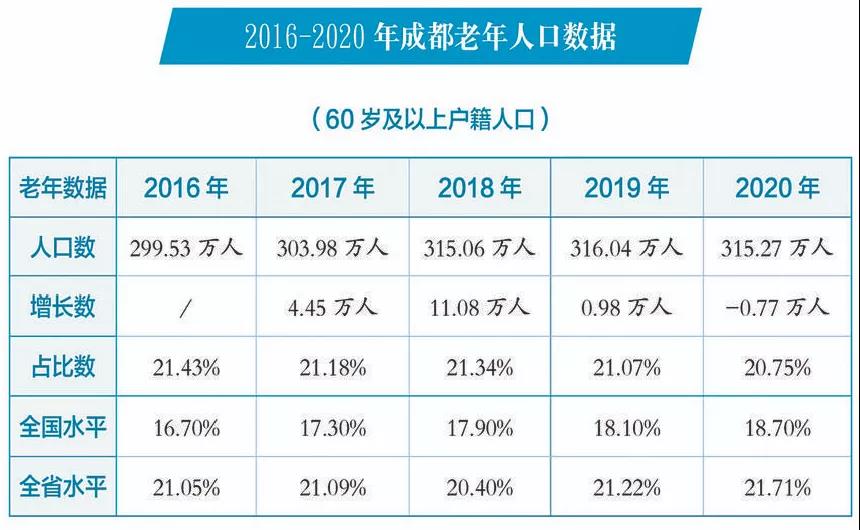
I. The aging population is steadily declining and will continue to improve, dropping to the lowest level in five years in 2020.
In recent years, the proportion of the registered elderly population in chengdu has remained stable but declined. Since 2016, the proportion of the registered elderly population has been 21.43%, 21.18%, 21.34%, 21.07% and 20.75%, respectively. Last year's figure was the lowest in five years after the figure exceeded 20 percent in 2014.

Ii. The proportion of registered elderly population declined for two consecutive years and the absolute number declined for the first time, but the absolute number of permanent elderly population was high.
In 2019 and 2020, the proportion of registered elderly population declined for two consecutive years, and the growth rate was lower than that of registered population for two consecutive years. In 2020, the registered elderly population decreased by 70,700 from 2019, marking the first decline in the number. However, the number of permanent elderly residents is 3,764,100, posing a challenge to various public services related to old-age care.
 Iii. The proportion of the younger aged population (60 to 79 years old) in the registered elderly population has decreased for three consecutive years, while the proportion of the elderly population (80 years old and above) has increased for three consecutive years. The average age of registered elderly population increases.
Iii. The proportion of the younger aged population (60 to 79 years old) in the registered elderly population has decreased for three consecutive years, while the proportion of the elderly population (80 years old and above) has increased for three consecutive years. The average age of registered elderly population increases.
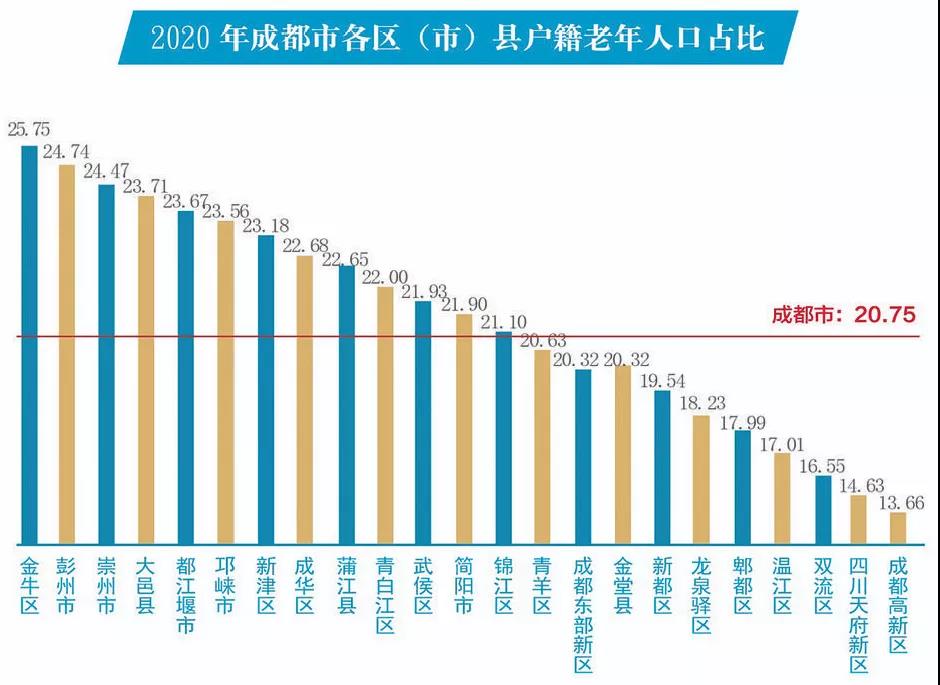
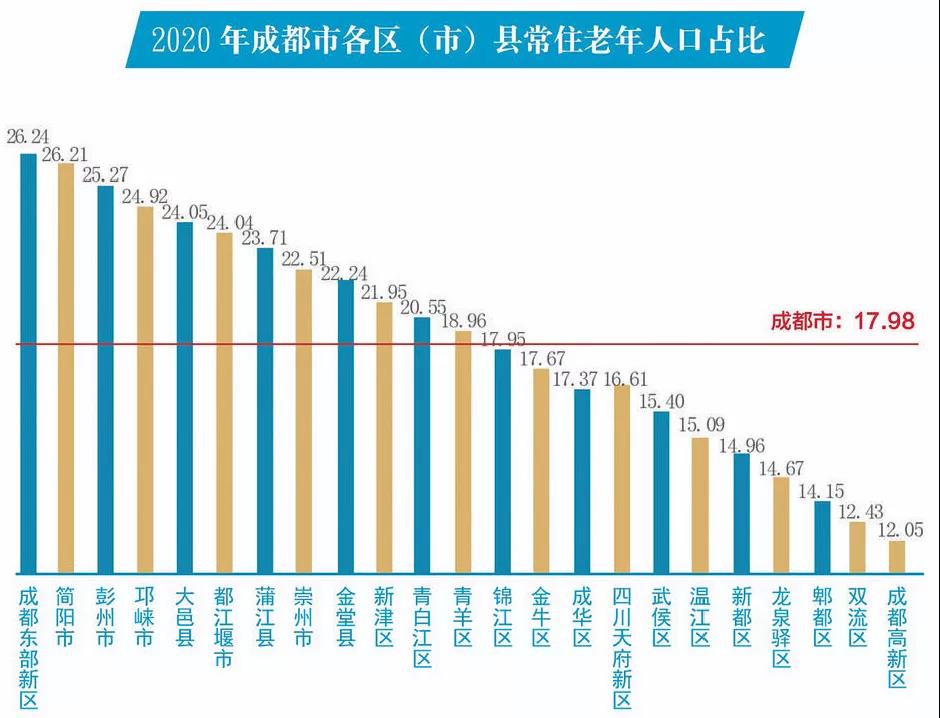
Iv. In 2020, the proportion of registered elderly population in The city was 20.75%, lower than the level of the previous year.
The degree of aging varies greatly among regions (cities) and counties, with the proportion of registered elderly population in 18 regions (cities) lower than the same period in 2019.
The results of the seventh national census show that in 11 of the 23 districts (cities) and counties of The city, the proportion of permanent elderly residents is lower than the city average of 17.98 percent.
Ii. Development of health services for the elderly
(1) The health service system for the elderly has been gradually improved

1. The supply of geriatric medical services has increased
In 2020, there were 17 geriatric hospitals in the city; There are 133 medical institutions offering geriatric medicine; There were nearly 7,000 beds for elderly patients, nearly 1,000 more than in 2019.
There were 73 geriatric medical institutions in secondary and above general hospitals, and the proportion of secondary and above medical institutions increased from 46.88% to 51.77%.
2. The development of institutions integrating medical care and elderly care was accelerated

By the end of 2020, there were 108 medical and nursing institutions in The city, 90 of which had been designated for medical insurance. There were 55 medical and health institutions providing elderly care services, and 53 nursing institutions with medical and health services.
The city has 30,332 beds in medical and nursing institutions, including 13,648 medical beds, 16,684 beds for the elderly, and 14,615 medical and nursing service personnel. 404 pairs of medical and health institutions have established cooperative relationships with elderly care institutions, and 1621 pairs of medical and health institutions have established cooperative relationships with day care centers to provide combined medical and nursing services for the elderly.
3. The number of pension service institutions increased
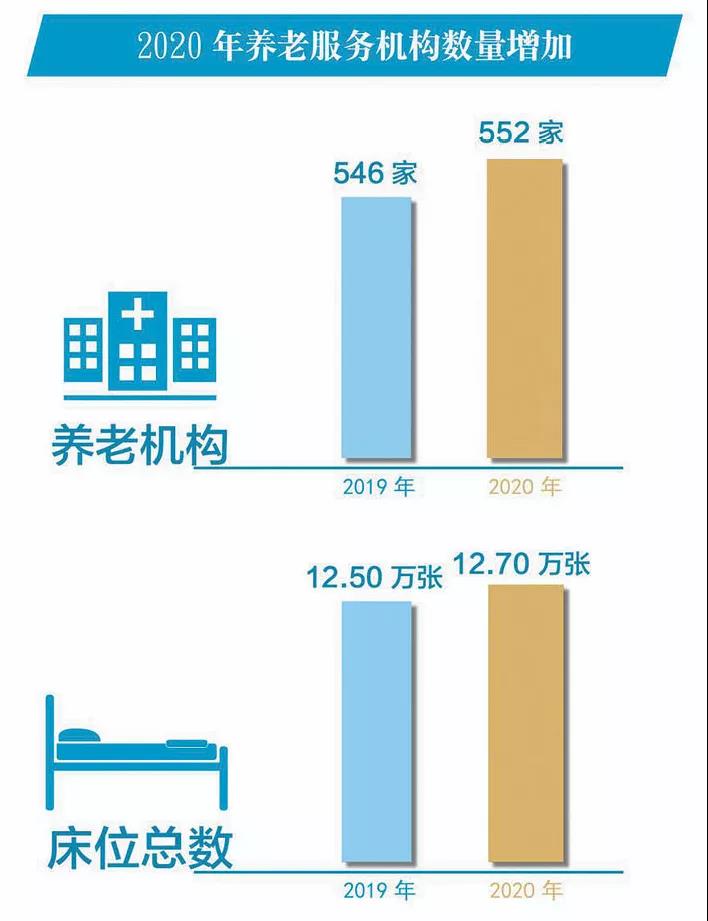
In 2020, there were 552 pension institutions in the city, 6 more than in 2019, an increase of 1.10%. The total number of beds is 127,000 (including preparation), an increase of 0.2,000 or 1.57% over 2019.
(2) Health services for the elderly continue to improve
1. The average life expectancy continues to rise
In 2020, the average life expectancy of the city was 81.52 years, 0.51 years more than in 2019. With the further deepening of population aging, the average life expectancy of Our city will continue to improve in the future.
Second, the elderly health management level gradually improved
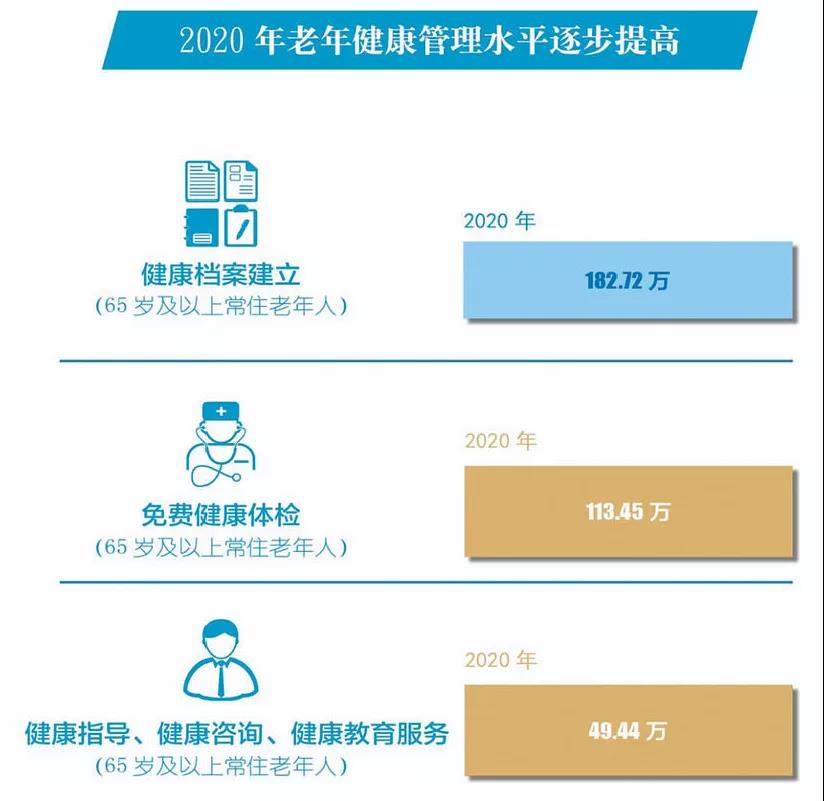
In accordance with the national statistical standards for key public health service objects (permanent elderly population aged 65 and above), in 2020, the city set up health records for 1,827,200 elderly people, provided free health examination for 1,134,500 elderly people, and provided health guidance, health consultation and health education services for 494,400 elderly people.
3. The model of combining medical care and elderly care in home-based communities has been improved
Through the contract cooperation mode of relying on primary medical institutions, the integrated operation mode of combining medical and nursing care, the contract service mode of combining medical and nursing care in home community with family doctors, and the multi-institution regional cooperation mode, the elderly care service in home community combining medical and nursing care is carried out.
4. Trials of hospice care services were actively advanced
In 2020, the city identified one hospice care demonstration center and 23 medical and health institutions in line with the pilot work of hospice care, with 406 beds and more than 4,500 hospice care services for the elderly at the end of life.
5. Effective response to COVID-19
In the face of COVID-19, the city has established a joint prevention and control management mechanism, and strengthened the promotion of prevention and control knowledge and guidance of prevention and control skills for the elderly through multiple channels and in various forms, effectively improving their protection ability.
We will guide and urge medical and elderly care institutions to carry out regular management in accordance with epidemic prevention and control requirements, improve emergency response plans for medical and elderly care institutions for public health emergencies, and ensure adequate protection for all staff in these institutions. The city's elderly health work has withstood the test of the epidemic.
3. Health services for the elderly continued to improve
1. The total number of elderly people insured by basic medical insurance is on the increase

In 2020, there were 2.121,400 retirees (including those under the age of 60) participating in the basic medical insurance for urban workers, an increase of 80,800 or 3.96 percent over 2019, and the medical expenses were 11.781 billion yuan, a decrease of 1.072 billion yuan over 2019.
A total of 1.3423 million elderly people participated in the basic medical insurance for urban and rural residents, 16,700 more than in 2019, or 1.26 percent more than in 2019, resulting in medical expenses of 4.763 billion yuan, 285 million yuan less than in 2019.
2. Living security for the elderly in need has been improved year by year

In 2020, the city provided 390,100 elderly people with subsistence allowances, and provided 197 million yuan of subsistence allowances for the whole year.
A total of 325,700 elderly people in extreme poverty in rural areas were assisted, an increase of 8,600 over 2019.
A total of 24,700 elderly people in extreme poverty in urban areas have been assisted, 10,001 more than in 2019.
A total of 303 million yuan of living subsidies were provided to elderly people in extreme poverty in urban and rural areas last year, an increase of 0.01 million yuan over 2019.
The allowance for the elderly in extreme poverty should be no less than 1,105 yuan per person per month in central urban areas and no less than 1,040 yuan per person per month in rural areas.
3. Reward and support policies will be implemented for the elderly in special family planning families

Assistance to the elderly from families with special family planning requirements has been increased year by year. In 2020, the standard for special assistance to parents of families whose only child has died will be raised from 760 yuan to 860 yuan per person per month, and for parents of families whose only child is disabled from 600 yuan to 680 yuan per person per month.
In 2020, a total of 966 million yuan was allocated to the three systems of family planning incentives and assistance.
Iv. Long-term care insurance benefits shall be provided to the disabled elderly
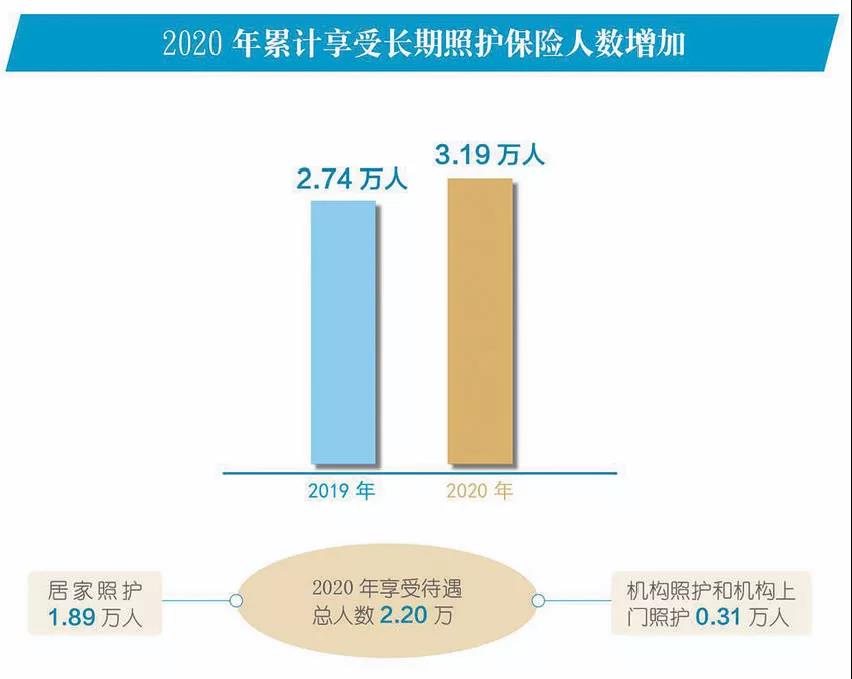
By the end of 2020, a total of 43,200 people had accepted the disability assessment of long-term care insurance in The city, and a total of 38,000 had passed the preliminary assessment, and a total of 31,900 had passed the assessment and enjoyed benefits, with a pass rate of 86.89%.
Among them, in 2020, 8,009 people were added to the acceptance disability assessment, 6,627 passed the preliminary examination, and 5,465 passed the assessment and enjoyed benefits. The total number of people receiving benefits in 2020 was 22,200, an increase of 0.06,000 or 2.8 percent over 2019, including 18,900 for home care and 10,100 for institutional care and in-home care.
5. Preferential treatment for the elderly continues to improve
In 2020, 34,100 copies of "Chengdu Advanced Certificate for the Elderly" and 28,800 copies of "Sichuan Advanced Certificate for the Elderly" were issued.
A total of 447 million yuan was paid to 652,500 senior citizens aged 80 or above. Free rehabilitation AIDS were provided to 77,300 disabled senior citizens, an increase of 21.73 percent over 2019.
6. Jointly promote the development of health services for the elderly
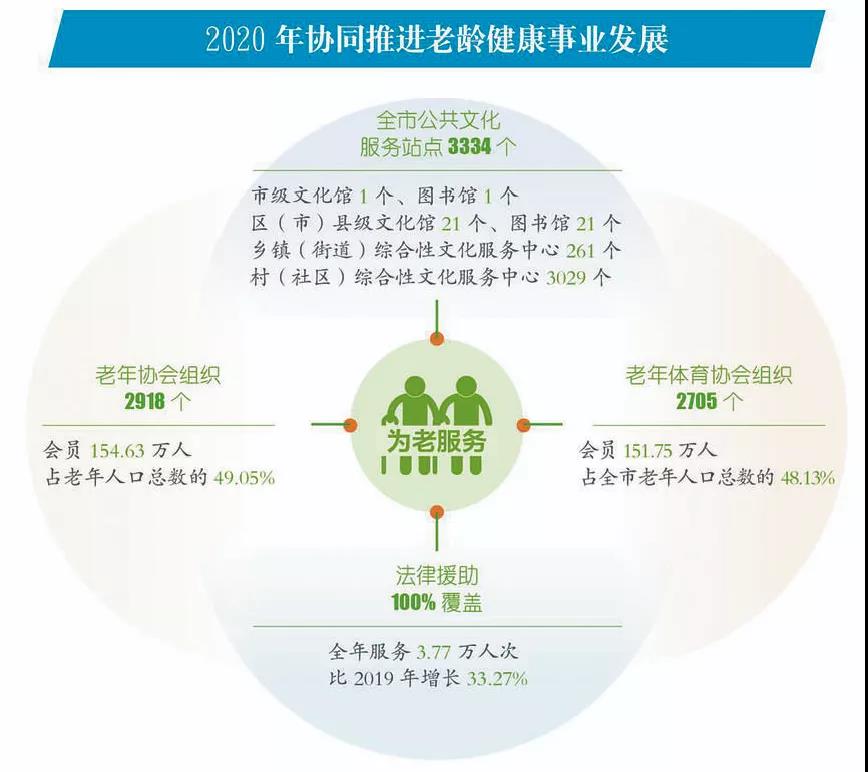
In 2020, the city university of relying on the old city and county (area, city), villages and towns (street), three-level network and radio and television university campus and community education institute, upgrade perfected the "chengdu elderly education public service platform", for the old people in the city provide a wide range of audio, video and electronic books online learning resources, such as old age education service network basic form.
A total of 3334 in the city of public cultural services site, for the majority of the elderly to provide various forms of public cultural services, among them, the municipal cultural center 1, library 1, area (city) county cultural center 21, 21, a library of villages and towns (street) is a comprehensive cultural services center, 261, the village (community) is a comprehensive cultural services center, 3029.
The coverage of legal aid for qualified senior citizens reached 100 percent, and the city provided 37,700 legal services to senior citizens in 2019, an increase of 33.27 percent over 2019.
In 2020, there were 2,918 associations for the elderly at all levels in the city, with 1,546,300 members, accounting for 49.05% of the total elderly population (Tianfu New Area and Eastern New Area were not included in the statistics). There are 2,705 sports associations for the elderly at all levels, with 1,517,500 members, accounting for 48.13% of the total elderly population. Mass organizations for the elderly are flourishing, and colorful activities play an active role as a bridge linking the party and the government to the elderly.
Article source: Chengdu Daily
相关推荐
- China Daily | The 10th Guangzhou Elderly Expo is scheduled for August 2026, inviting you to attend the Silver Hair Expo together 2025-11-28
- The linkage of three old exhibitions in Guangdong, Shaanxi, and Jiangsu, with an exhibition scale of over 100000 square meters! Seize the national silver economy market! 2025-04-21
- 4-day 3-night high-end inspection tour of the Korean healthcare industry! 2025-02-14
- The 9th (Guangzhou) EldExpo Silver Hair Economy Investment Promotion Conference was successfully held in Guangzhou 2025-06-27

